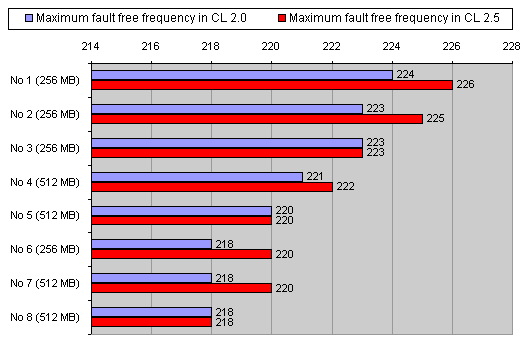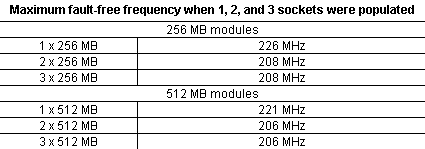|
|
|
|
|
Winbond DDR400 Mega Test |
|
Join the community - in the OCAU Forums!
|
Results and Conclusions
Results
The first good news is that we did not experience any of the problems reported with other DDR 400 products. All of the tested Winbond DDR 400 BH-5 based Twinmos PC 3200 modules were running without any problem and that - as table below shows - above the advertised frequency of 2 x 200 MHz.

Most of them were good for at least 220 MHz in CL 2.0. The 512 MB modules have a slightly lower frequency headroom than the 256 MB modules. An explanation could be that even though using identical memory chips on the 256 and 512 MB modules, the double number of them on the 512 MB module increases the probability to have a “weak” one among them, and the weakest chip sets unfortunately the pace for the entire crew. All in all: this is a very good result.

The bandwidth as reported by Memtest-86 looks inconsistent when CL 2.5 and CL 2.0 are compared. Indeed it looks more like random differences and we don’t regard these values as very meaningful. Goldmemory returned similar random differences between CL 2.5 and CL 2.0 (at a generally lower level), and Sandra did not show any difference. Maybe there is no difference between CL 2.0 and CL 2.5 when the memory is running at such extreme frequencies. In any case we think it’s more meaningful to check the latency impact with application based benchmarks like Content Creation 2002, Business Winstone 2001 Winstone, or game time demos.
Only as reference we show here a SANDRA memory benchmark score taken with a 256 MB module at 238 MHz in CL 2.5. The same module could only complete 3 fault free runs in Memtest-86 at 220 MHz. As already mentioned, SANDRA identified all tested Twinmos PC 3200 non-ECC RAM modules as ECC memory.

The difference between the tested modules in terms of highest achievable frequency was less than 3%. This result was actually quite surprising for us, because based on our experience with other memory products we expected a far wider deviation. Such a tight range is indicating good production quality with small tolerances. The frequency headroom range is something what the buyer should always keep in mind. There is always a risk to get a module from the lower end of the performance range. The bragging neighbor’s excellent result might be (unknowingly) achieved with a “Golden Sample”. The risk is even bigger with non-branded modules. Often (not always) there is a considerable quality difference between branded and non-branded (OEM) RAM modules. Even using identical RAM chips; cheaply produced OEM sticks are often yielding much lower frequency headroom than branded RAM modules The difference comes from the PCB quality (4 versus 6 layer) the stick design/layout, and probably differences in the production process

We found that using DIMM socket 2 and socket 3 in a few cases slightly reduced the module’s frequency headroom. This finding is not new and has been observed many times before with all sorts of RAM. It’s probably the penalty for the longer distance the data have to travel between the module and the CPU. More important are our results when 2 or even 3 DIMM sockets were populated with memory modules. We found that running 2 modules be it the 256 MB or the 512 MB variety, is substantially reducing frequency headroom. We could not run more than 1 256 MB module above 208 MHz and the 512 MB module above 206 MHz.
Conclusion
After testing 8 modules with both 256 MB and 512 MB we are confident to qualify the tested Winbond DDR 400 based Twinmos PC 3200 as a solid performer. The 512 MB modules were fault-free running between 218 and 221 MHz. The 256 MB modules were fault free running between 218 and 224 MHz with a latency of 2.0. The is around 10% above the advertised DDR 400 specification of 2 x 200 MHz and notably with a latency of 2.0 instead of the advertised 2.5. This is high performance memory and with a street price in Asia of around 100 USD for the 256 MB module and 180 USD for the 512 MB module certainly a good buy.
The less impressed reader looking at his apparently “higher” Sandra frequencies should keep in mind that the maximum memory frequency under Sandra can complete a memory benchmark has often to be reduced by 20 MHz or more to produce fault free tests with Goldmemory or Memtest-86. Or with other words: Sandra does not say much about your memory’s frequency headroom.
It seems to be difficult to get Twinmos PC 3200, in particular 256 MB modules outside of Asia, but several other 3rd party manufactures like Corsair are now also using the Winbond DDR 400 chips for their top of the line products. As already mentioned we recommend to be careful when buying non-branded /OEM modules: the Winbond 400 DDR BH-5 RAM chips might not run as good as on the Twinmos PC 3200 modules we have tested here.
|
|
Advertisement:
All original content copyright James Rolfe.
All rights reserved. No reproduction allowed without written permission.
Interested in advertising on OCAU? Contact us for info.
|

|


